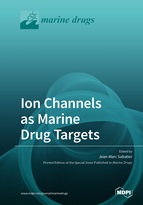Ion Channels as Marine Drug Targets
A special issue of Marine Drugs (ISSN 1660-3397).
Deadline for manuscript submissions: closed (30 October 2020) | Viewed by 27530
Special Issue Editor
Interests: antimicrobial peptides; antibacterial; antibiotics; structure-activity relationships; bacteriocins; drug design; peptide engineering
Special Issues, Collections and Topics in MDPI journals
Special Issue Information
Dear Colleagues,
Animal venoms, especially of marine origin, are rich natural sources of bioactive compounds. The molecular targets of the latter are mainly ion (i.e., sodium, potassium, calcium, and chloride) channels with their numerous variants/subtypes. These venom molecules are exhibiting diverse potencies and selectivities and may have some therapeutic potential based on their cellular targets. Over the past decade, marine molecules have been widely studied, as they represent potential drugs to treat a variety of (human) pathologies, from pain to autoimmune and neurological diseases. This Special Issue of “Marine Drugs” is devoted to the different aspects of the marine (or marine-derived) molecules, from the discovery and structural characterization to the pharmacology and molecular engineering in order to finally develop some “novel” candidate chemotherapeutic drugs targeting the ion channel(s).
Dr. Jean-Marc Sabatier
Guest Editor
Manuscript Submission Information
Manuscripts should be submitted online at www.mdpi.com by registering and logging in to this website. Once you are registered, click here to go to the submission form. Manuscripts can be submitted until the deadline. All submissions that pass pre-check are peer-reviewed. Accepted papers will be published continuously in the journal (as soon as accepted) and will be listed together on the special issue website. Research articles, review articles as well as short communications are invited. For planned papers, a title and short abstract (about 100 words) can be sent to the Editorial Office for announcement on this website.
Submitted manuscripts should not have been published previously, nor be under consideration for publication elsewhere (except conference proceedings papers). All manuscripts are thoroughly refereed through a single-blind peer-review process. A guide for authors and other relevant information for submission of manuscripts is available on the Instructions for Authors page. Marine Drugs is an international peer-reviewed open access monthly journal published by MDPI.
Please visit the Instructions for Authors page before submitting a manuscript. The Article Processing Charge (APC) for publication in this open access journal is 2900 CHF (Swiss Francs). Submitted papers should be well formatted and use good English. Authors may use MDPI's English editing service prior to publication or during author revisions.
Keywords
- ion channel
- immunomodulator
- pain killer
- candidate drug
- marine drug
- structure-activity relationships
- venomous marine animal
- animal venom
- toxin
- sea snake
- sea anemone
- jellyfish
- stingray
- puffer fish
- scorpion fish
- marine cone snail







